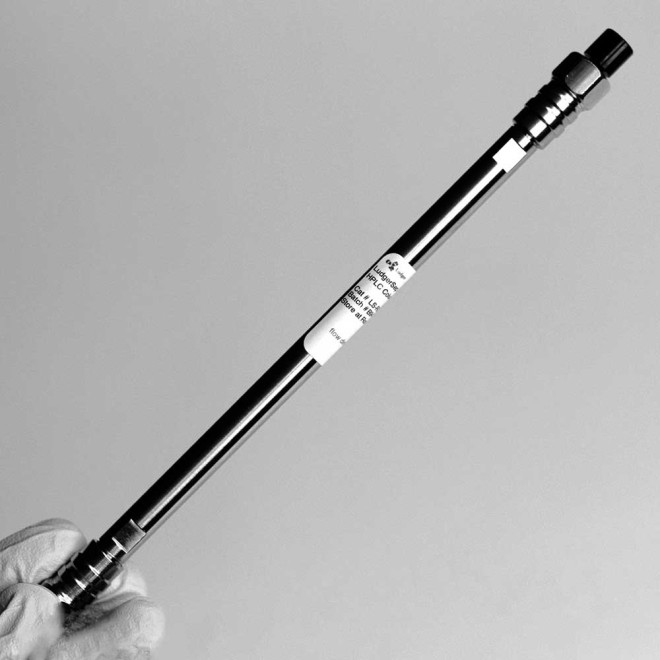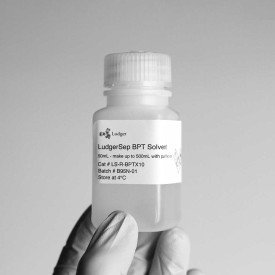LudgerSep R2 HPLC column
Analysis by HPLC of 2-AA labelled monosaccharides in conjunction with the LudgerTag Quantitative Monosaccharide Analysis Kit (Catalogue No. LT-MONO-96).
The LudgerSep™ R2 HPLC column contains particles with an octadecylsilane coating optimized for hydrophobic chromatography.
Product specifications
Application: Analysis of monosaccharides labeled with 2-aminobenzoic acid (2-AA).
Description: The LudgerSep™ R2 HPLC column contains particles with an octadecylsilane coating optimized for hydrophobic chromatography.
Particles: 3 μm silica derivatized with octadecylsiliane coating. 175 Angstrom pore size.
Column size:
| Cat # | Diameter x Length | Column Volume |
|---|---|---|
| LS-R2-4.6x150 | 4.6 x 150 mm | 2.49 ml |
Column Tube: Stainless steel
Flow Rates: Typical flow rates = 0.3 – 2.0 ml/min.
Column Pressure: Pressure should not exceed 2000psi.
pH Range: 2 - 8
Temperature:Typical operating temperature = 30 oC, but increasing the temperature may improve resolution for some samples. Maximum temperature range = 15 - 50 oC.
Solvents: Solvent A: 0.2% butylamine/ 0.5% phosphoric acid/ 1% tetrahydrofuran in purified water. Solvent B: Acetonitrile. Avoid strong oxidants and anionic detergents.
Column Protection: Filter all solvents to 0.2 m and degas using either helium sparging or vacuum degassing. Filter all samples using a 0.2 μm filter membrane before loading onto the column. Install a good quality in-line filter between the sample injector and the column. Please call us for advice on the most suitable sample and in-line filters to use. Long term storage of the column should be in solvent containing at least 30% acetonitrile.
Suitable Sample: Monosaccharides labeled with 2-aminobenzoic acid (2-AA)
Sample Preparation: Filter samples to 0.2 μm and avoid exposure to light. Dissolve samples in Solvent A.
Sample Detection: Fluorescence. Excitation: 360 nm. Emission: 425 nm.
Handling: Ensure that any glass, plasticware or solvents used are free of glycosidases and environmental carbohydrates. Use powder-free gloves for all sample handling procedures and avoid contamination with environmental carbohydrate.
Safety:Please read the Material Safety Data Sheets (MSDS's) for all chemicals used. All processes involving labelling reagents should be performed using appropriate personal safety protection - eyeglasses, chemically resistant gloves (e.g. nitrile), etc. - and where appropriate in a laboratory fume cupboard.
For research use only. Not for human or drug use
HPLC System Requirements
The LudgerSep™ R2 column can be used with any HPLC pumping system capable of delivering accurate gradients at a flow rate of 0.3 to 2.0 ml/min. In general, systems that mix eluants at high pressure (after the pump head) have lower dead volumes and supply more accurate gradients that are appropriate at the flow rate needed for LudgerSep columns. Low dead volume injectors should be used (Rheodyne 7125 / 9125 or similar are recommended). The loop size to be used depends on the separation mode and amount of sample. For analytical runs it is desirable to minimise the sample volume and, typically, a 10 μl loop is used with sample injection volumes of 1 to 5 μl (partial fill) or > 10 μl (complete fill). For charge mode separations, generally, anionic glycans that are retained by the column (and are therefore effectively concentrated on the column) are reasonably tolerant of larger injection volumes whereas non-anionic glycans are not retained by the column matrix and will elute in a volume proportional to the injection volume.



 Product guide
Product guide
